Goa 20,000 Rest of India 1,000 | Mangalore 5,000 | |
 | ||
The Roman Catholic Brahmin, also referred to as Bamonn (Devanagari: बामण, Kannada: ಬಾಮಣು; IAST: Bāmaṇ; pronounced /baməɳ ~ bamɔɳ/) in Konkani, is a caste among the Goan and Mangalorean Catholics, of modern-day descendants of Konkani Brahmin converts to Roman Catholicism.
Contents
Origins
In Goa, the Brahmins were originally engaged in the priestly occupation, but had taken up various occupations like agriculture, trade, goldsmithy, etc. The origins of this particular caste can be traced back to the Christianisation of the Velhas Conquistas (Portuguese: Old Conquests) that was undertaken by the Portuguese during the 16th and 17th centuries. It was during this period that the Jesuit, Franciscan and Dominican missionaries converted many Brahmins to Christianity. The first mass conversions took place among the Brahmins of Divar, and the Kshatriyas of Carambolim. In his Oriente conquistado a Jesu Christo pelos padres da Companhia de Jesus da Provincia de Goa (1710), Portuguese Jesuit priest, Fr. Francisco de Sousa gives an account of the mass conversions of Brahmins in Divar:
All converts from Brahmin sub-castes such as the Goud Saraswat Brahmins, Padyes, Daivadnyas, etc., were lumped into the Christian caste of Bamonn. Since the conversions of Brahmins of a particular area became instrumental in the conversions of members of other castes, such converts were highly valued and esteemed by the church and Portuguese authorities alike. They were even allowed to wear the Yajnopavita (sacred thread) and other caste markings by special dispensation of Pope Gregory XV in 1623, on the condition that these were blessed by a Catholic priest. Historian Charles Ralph Boxer observed:
"The converted Brahmenes retained their pride of caste and race, and they very seldom intermarried with the Portuguese and never with their Indian social inferiors. Similarly, the lower castes who became Christians did not lose their ingrained respect for the Brahmenes, and they continued to venerate the latter as if they were still their 'twice-born' (dvija) and natural superiors."
The Bamonns in general, consider their caste system to be an Indian class form of social categorisation. Since their concept is divorced from all the religious elements associated to it by their Hindu counterparts, they tend to justify their maintenance of caste as a form of social stratification similar to the Western class concept. Traditionally, they are an endogamous group and have refrained from inter-marriage with Catholics of other castes. However, while the Bamonns never inter-married or mingled with the low caste Sudirs (Konkani: Shudras), Mahars, and Chamars, the statutes and norms of the Roman Catholic church restrained them from discriminating against the latter. Although most now carry Portuguese surnames, they have retained knowledge about their paik (ancestral pre-conversion surnames) such as Bhat, Kamat, Nayak, Pai, Prabhu, Shenoy, and Shet. The konkanised variants of these surnames are Bhôtt, Kāmot, Nāik, Poi, Porbų (Probų), Šeņai, and Šet. Mudartha is a unique surname to be found among some Bamonn families that hail from Udupi district in Karnataka. Bamonns constitute the largest caste in the Mangalorean Catholic community. Most Mangalorean Catholic Bamonn families trace their patrilineal descent to Goud Saraswat Brahmins, with a small minority to Daivadnya Brahmins. There were a few historical instances in the Mangalorean Catholic community, wherein some Anglo-Indians were admitted into the Bamonn fold by Catholic priests. Their descendants are known as Pulputhru Bamonns (Pulpit Bamonns).
A 1976 genetic analysis study conducted on three groups of Saraswat Brahmins and one group of Goan Catholic Bamonns in Western India, confirmed the historical and ethnological evidence of a relationship between Goan Catholic Bamonns and Chitrapur Saraswat Brahmins. The study further revealed that intergroup differences between the subject groups suggested a genetic closeness, with genetic distance ranging from 0.8 to 1.5.
In popular culture
"No, I'm not going to
delve deep down and discover,
I'm really de Souza Prabhu
even if Prabhu was no fool
and got the best of both worlds.
(Catholic Brahmin!
I can hear his fat chuckle still.)"
